Saints Row: Gat Out of Hell – Review
by Edward
|
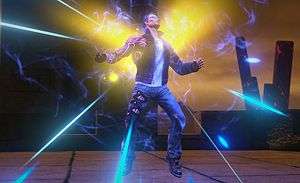 I’ve never fully understood the fascination with Johnny Gat. As someone who started the Saints Row series with The Third, it’s more than a bit confusing to see so much reverence for a character who disappears before you’ve even hit the sandbox, returns to so much fanfare in IV, then exists as background decoration for the rest of the game. Was he really important, or a fan favourite in Saints Row 2? Is it an ironic joke where he’s loved and popular purely because everyone pretends he is? Is it like Ubisoft calling Aiden Pearce’s cap iconic in the vain hope that insisting it enough times will make it true?
I’ve never fully understood the fascination with Johnny Gat. As someone who started the Saints Row series with The Third, it’s more than a bit confusing to see so much reverence for a character who disappears before you’ve even hit the sandbox, returns to so much fanfare in IV, then exists as background decoration for the rest of the game. Was he really important, or a fan favourite in Saints Row 2? Is it an ironic joke where he’s loved and popular purely because everyone pretends he is? Is it like Ubisoft calling Aiden Pearce’s cap iconic in the vain hope that insisting it enough times will make it true?
Unfortunately, by the time I finished Gat Out of Hell - the standalone-expansion-slash-pseudo-sequel to Saints Row 4 – I was no closer to getting an answer. Taking place an unspecified amount of time after the main game, the story begins when the remnants of The Saints mess about with a ouija board for Kinzie Kensington’s birthday, resulting in The Boss being kidnapped by Satan and dragged into Hell in order to marry his daughter Jezebel. Determined to rescue their leader, Gat threatens the ouija board until it grants him passage to Hell and takes Kinzie along for the ride as a birthday gift.
The gameplay itself will be more than familiar to anyone accustomed with the series; Gat and Kinzie must take on missions and perform side activities in order to wreak havoc across Hell and teach The Devil that he should never mess with The Saints. Not only is (re)death and destruction the order of the day, but our heroes must also team up with some of the afterlife’s most prominent figureheads and help them conquer their own respective parts of the Underworld in order to gain access to new superpowers and help usurp Lucifer’s grasp of his kingdom.
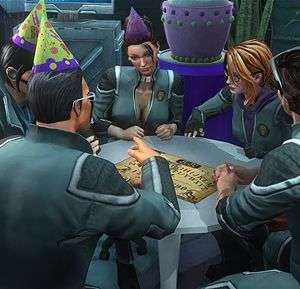 Much like Saints Row 4 before it, Gat Out of Hell bestows a series of superpowers onto your characters; the former game doing so because you’re living in a simulation, the latter because you’ve possession of Lucifer’s cracked halo. While the familiar blast and stomp abilities return, albeit with different mutations that the player must unlock through side activities, there are two new powers in the form of summons and auras. Summons are relatively self-explanatory, allowing either Saint to conjure an imp to help assist them in combat, with more minions and explosive send-offs available through levelling, and larger, more powerful creations able to be summoned by finding specific altars across the map. Meanwhile, auras will deal persistent damage to anyone within a certain distance of your hero, and the vampire mutation that drains health from your opponents and gives it to you can be very useful in some of the more hectic battles.
Much like Saints Row 4 before it, Gat Out of Hell bestows a series of superpowers onto your characters; the former game doing so because you’re living in a simulation, the latter because you’ve possession of Lucifer’s cracked halo. While the familiar blast and stomp abilities return, albeit with different mutations that the player must unlock through side activities, there are two new powers in the form of summons and auras. Summons are relatively self-explanatory, allowing either Saint to conjure an imp to help assist them in combat, with more minions and explosive send-offs available through levelling, and larger, more powerful creations able to be summoned by finding specific altars across the map. Meanwhile, auras will deal persistent damage to anyone within a certain distance of your hero, and the vampire mutation that drains health from your opponents and gives it to you can be very useful in some of the more hectic battles.
In reality, however, the new powers pale in comparison to the returning abilities, and even your most destructive summon or aura is nothing compared to a well-placed blast or a well-timed stomp. Since you can also collect the powers in any order you want, I ended up having a near-fully-powered stomp ability before I’d even learned how to summon, rendering my newly acquired horde of imps practically useless in comparison. In fact, the stomp ability can become so overpowered that destroying spires or taking part in some of the side activities can take a matter of seconds, rather than minutes, to complete.
 |
 |
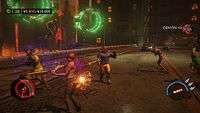 |
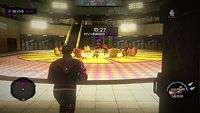 |
 |
 |
This wouldn’t be so much of an issue if there were plenty to do in Gat Out of Hell, but side quests are relatively thin on the ground this time around. A smaller map means fewer things to do, but it’s also compounded by the fact that most of the tasks involve taking down spires or surviving waves of enemies to a quota. Those same tasks were prevalent within Saints Row 4, but they were offset by the myriad of other activities and main story missions; in Gat Out of Hell, they’re an overwhelming majority of the gameplay. Heck, even the altars that bestow new elements to your superpowers are nothing more than ‘kill x number of enemies’ fun-fests.
 This imbalance is compounded by the fact there’s only one new activity to play through – tasking you with smacking ‘college bro’ demons through rings – but only three instances of it across the map, and the remaining bunch of things to do are mostly just bare-bones re-skins of familiar classics that simply stick with the “if it ain’t broke” approach. The only improvement comes from Torment Fraud, perhaps because it puts you in control of a shambling corpse instead of a super-powered force of nature, but definitely because each of its three instances come with a purposefully elaborate narrated back-story that tells you who you’re controlling and exactly why you need to throw them in front of cars.
This imbalance is compounded by the fact there’s only one new activity to play through – tasking you with smacking ‘college bro’ demons through rings – but only three instances of it across the map, and the remaining bunch of things to do are mostly just bare-bones re-skins of familiar classics that simply stick with the “if it ain’t broke” approach. The only improvement comes from Torment Fraud, perhaps because it puts you in control of a shambling corpse instead of a super-powered force of nature, but definitely because each of its three instances come with a purposefully elaborate narrated back-story that tells you who you’re controlling and exactly why you need to throw them in front of cars.
The constant survival hordes would be far more fun if the guns were anything to shout about, but they’re honestly not. All of the standard guns you collect throughout gameplay are seriously boring in comparison to the likes of, say, the infamous dub-step gun, and just about get the job done. As you progress and explore, you’ll soon come across weapons based on the seven deadly sins, but these don’t fare much better. Even the best of these – an armchair equipped with dual mini-guns – needs plenty of upgrading before the positives overcome its many serious drawbacks. That being said, one of the standard weapons fires explosive frogs at people, but even that’s slightly more difficult to make the best of than it is briefly amusing.
Perhaps the biggest disappointment with Gat Out of Hell is just the fact that it isn’t even all that funny. It starts out promisingly thanks to an amazing opening cutscene that contains possibly my favourite joke of the series, but slowly trundles downhill from there. That’s perhaps a bit disingenuous, because what’s actually the case is that nearly all of the fully-animated cutscenes contain a few solid laughs, but everything else falls short. The lack of consistency in tone and humour comes across as if the animated sequences, the storybook narration, and the in-game dialogue were all written by entirely different teams who never consulted each other and then didn’t bother to make sure the jigsaw pieces fit before mashing them together.
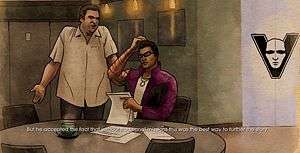 What makes it worse is that, outside of those fully-rendered cutscenes, the humour present is hands down the laziest seen in Saints Row The Third, 4, or any of their respective DLC, because nearly all of it does the incredibly, incredibly infuriating line of “humour” where all the jokes are “man, don’t you hate it when games make you do this thing we’re making you do now?” and openly pokes fun at itself in the hope you’ll laugh and accept it, rather than realise they’ve just exposed one of the many flaws.
What makes it worse is that, outside of those fully-rendered cutscenes, the humour present is hands down the laziest seen in Saints Row The Third, 4, or any of their respective DLC, because nearly all of it does the incredibly, incredibly infuriating line of “humour” where all the jokes are “man, don’t you hate it when games make you do this thing we’re making you do now?” and openly pokes fun at itself in the hope you’ll laugh and accept it, rather than realise they’ve just exposed one of the many flaws.
“Johnny Gat questioned the logic, but he accepted the fact that without traditional missions this was the best way to further the story“, the storybook will joke, showing you a picture of Johnny Gat scratching his head while reading a copy of the script at Volition’s studios, thinking that excuses Gat Out of Hell‘s complete lack of a logical structure or method of progression. “Man, I hope there’s not a hundred of these” Gat will quip when he first picks up the soul clusters needed to level up superpowers, only for you to later discover that the truth is worse than the joke, because there’s actually more like a thousand of the bloody things strewn about Hell. “This is repetitive” Kinzie will quip, not realising she’s inadvertently echoing your sentiments exactly.
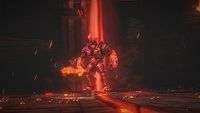 |
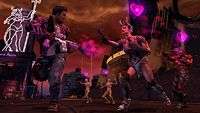 |
 |
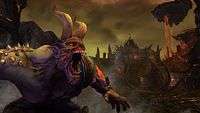 |
 |
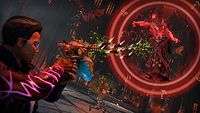 |
There’s a weird juxtaposition within the writing, and it’s hard not to notice it when each method of humour is at odds with another. The best way to summarise it is that the cutscenes deliver jokes by having fun with the premise, where the other elements deliver theirs by laughing at you for falling for it. Saints Row 4 was one of the funniest games around, but Gat Out of Hell is often like paying to see an encore performance of your favourite comedian only to discover that all they have left is a routine where they’re sadly farting into a tuba for twenty whole minutes.
 Perhaps the most tragic part about it is that, unlike Saints Row 4, there are far fewer opportunities to make your own humour through emergent gameplay, and because there’s no licensed soundtrack to speak of, you’re extremely unlikely to create an experience as memorable as the first time you created mayhem with the dub-step gun, throwing a tank at aliens to the strains of Haddaway’s ‘What Is Love‘, or gliding around the city before stomping on enemies to the sounds of ‘The Safety Dance‘.
Perhaps the most tragic part about it is that, unlike Saints Row 4, there are far fewer opportunities to make your own humour through emergent gameplay, and because there’s no licensed soundtrack to speak of, you’re extremely unlikely to create an experience as memorable as the first time you created mayhem with the dub-step gun, throwing a tank at aliens to the strains of Haddaway’s ‘What Is Love‘, or gliding around the city before stomping on enemies to the sounds of ‘The Safety Dance‘.
One of Saints Row‘s greatest strengths is its ability to create a weird, wacky story that you somehow end up caring about nonetheless, and Gat Out of Hell was so close to doing the same thing. The premise is a great one, but everything’s over way too quickly. The idea of the Saints trying to take over Hell is a brilliant one, and I was especially looking forward to playing through with Kinzie as a main character, but you’ve barely had time to sit down and pop the kettle on before it’s all over.
The reason for this is that, while the progression in previous iterations was dictated through the main story missions, Gat Out of Hell‘s eschews that format. Instead, the story progresses by how much of Hell you’ve managed to conquer and thus how much Satan is pissed off at you. It’s a novel idea in theory, but in execution it ends up being slightly problematic for several reasons.
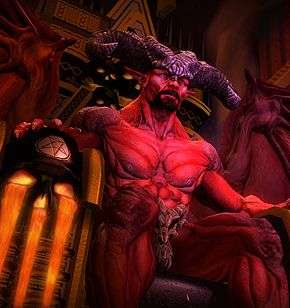 First, it means that you can’t actually enjoy the story at your own pace, or even avoid it entirely while you mess about and explore the Underworld; it’s a bit jarring when you’ll be completing a side activity only for the game to tell you to stop exploring, force you to watch a cutscene and then reset the action back at the Ultor building that acts as your starting location before letting you play again.
First, it means that you can’t actually enjoy the story at your own pace, or even avoid it entirely while you mess about and explore the Underworld; it’s a bit jarring when you’ll be completing a side activity only for the game to tell you to stop exploring, force you to watch a cutscene and then reset the action back at the Ultor building that acts as your starting location before letting you play again.
Second, it means that the story doesn’t get to make the most of its potential, and the consequence is that the supporting cast are practically “blink and you’ll miss it” cameos. The prospects of impaling your foes alongside Vlad, keelhauling bilge-rats with Blackbeard or getting theatrical with Shakespeare are enticing, which makes the each of their resultant single missions a bit of a waste. The game pretends you can do loyalty missions for them as well, but these “quests” are simply a case of doing all the side activities in their respective area until you’ve conquered it all.
There are other niggling problems as well. Despite boasting two playable characters, Kinzie’s presence feels like a total afterthought to the proceedings; she has perhaps five lines in total throughout the cutscenes – which focus almost entirely on Gat – it won’t let you play as her during the final story mission, and the storybook narration simply acts as if she doesn’t exist. It’s understandable in a game called “Gat Out of Hell“, but her existence is such a token effort that I doubt they’d even have included her at all if they didn’t have a co-op mode.
Meanwhile, there’s still the problem from Saints Row 4 where most of the abilities you can buy after levelling up are essentially useless the moment you get superpowers, and the pace is such that it feels like it’s rushing you to finish it rather than appreciate it. Everything is over far too quickly; you can reach the maximum level of twenty with thirty percent of the game still left to go, you can attempt the final encounter before you’ve finished most of the missions, thanks to the frankly barmy progression structure, and even taking the time to soak in the surroundings and explore whenever I could, I’d managed to have the entirety of Hell within my control in under five hours. It’s almost as though someone took the idea of getting Gat out of Hell way too seriously because you barely have enough time to terrorise the locals before you’re hurriedly ushered out via the credits sequence.
 It’s by no means a total disaster, however. It still looks pretty, the environments are genuinely a joy to explore, and it’s incredibly satisfying to level up your power of flight, ignore the litany of tasks ahead of you, jump off a building and not have to touch the ground for minutes at a time. But, when my favourite part of a title comes from sacking off the gameplay entirely, I start to worry that, somewhere, something has gone horribly wrong.
It’s by no means a total disaster, however. It still looks pretty, the environments are genuinely a joy to explore, and it’s incredibly satisfying to level up your power of flight, ignore the litany of tasks ahead of you, jump off a building and not have to touch the ground for minutes at a time. But, when my favourite part of a title comes from sacking off the gameplay entirely, I start to worry that, somewhere, something has gone horribly wrong.
I’m not sure what happened to Gat Out of Hell, but somewhere, something did indeed go horribly wrong. Overall, it honestly feels like it was shipped out to another company or a B-team within Volition who didn’t totally understand what made Saints Row The Third or 4 such memorable, brilliant experiences. As an expansion-slash-sequel, it feels less like a Greatest Hits package and more like a lazy cover album by people who aren’t entirely sure how to play their instruments and only vaguely know the lyrics, but don’t worry, because they’ve “totally got this, you guys“.
If this were a piece of downloadable content as part of a season pass it’d be less of a bitter pill to swallow, but considering it’s barely five hours long when you’re actively trying to avoid finishing it, the fact that it’s being sold on Steam for almost the same price as Saints Row 4 feels a little insulting. Despite everything going for it, Gat Out of Hell made the gameplay of Saints Row 4 – one of the best games of 2013 – feel totally and utterly average, and that’s its greatest sin of all.
Pros- It remembered what my version of the Boss looked like, which was a lovely - if brief - detail.
- Flying around Hell without a care in the (under)world is a joy.
- Has perhaps one of the funniest jokes in the entire series...
- ...But the rest of the game outside of the cutscenes relies on the lazy and infuriating tactic of making jokes about its own shortcomings, of which there are many.
- It takes fewer than five hours to have Hell 100% conquered. It's all over before you've even managed to get your pants off.
- One of the two playable characters comes across as an afterthought, rather than a selling point.
- Enough collectables to make an N64 game developed by Rare roll its eyes and sigh.
- The lack of a licensed soundtrack is sorely felt.
- New weapons and powers will leave you wanting.
- Most of the side-quests are bog-standard "kill x number of enemies to progress" affairs.
- Conjured up a potentially great supporting cast, and then utterly failed to make the best of it.
- The progression system is an interesting but ultimately flawed one, as it wrestles control away from you and restricts the ability to play at your own pace.
Considering Saints Row 4 was far and away one of the greatest games of 2013, the fact that Gat Out of Hell is such a short, average experience is a confusing one. With such a promising premise and releasing fifteen months after Saints Row 4, you'd expect something that built on the strengths of said predecessor and teased the series' exciting future, or acted as a graceful swansong to the franchise. Instead, the player is left with neither. The story never realises its potential, you'll have seen everything within five hours, and the developers have somehow made the gameplay less fun, interesting, and memorable than what was there before. If you're that desperate to experience the world of Saints Row again, then you're honestly better off replaying The Third or giving 4 another bash. A tough one to recommend, even to series die-hards.
Last five articles by Edward
- Best of 2015: Journey's End: A New Beginning
- Journey's End: A New Beginning
- You Can't Choose Your Happy Ending
- Okay, Let's Fix Comedy In Games - The V-Effekt
- Time Keeps On Smashing Away





















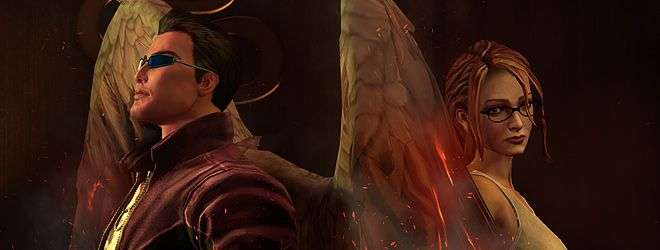






There are no comments, yet.
Why don’t you be the first? Come on, you know you want to!